


Golden crystals -- beautiful lead (II) iodide
Lead (II) ions and iodide ions can be combined to form a beautiful bright yellow precipitate. This is one of the more spectacular precipitation reactions. When a colorless solution of potassium iodide and a colorless solution of lead acetate or lead nitrate are added to each other, then a beautiful precipitate is formed.
Lead (II) iodide is slightly soluble in hot water and this fact can be exploited to create beautiful gold-like crystals of lead (II) iodide. Especially the formation of these crystals and the glittering "yellow snow", falling out of the solution is really nice to observe.
 This is a
beautiful experiment, but one has to be very careful with the lead (II)
compounds. Unfortunately, these are very poisonous. Lead (II) ions are a
cumulative poison. Multiple small doses, spread out over a long period of time
add up to form dangerous doses. So, when performing this experiment, be
particularly careful not to be exposed to the lead (II) compounds.
This is a
beautiful experiment, but one has to be very careful with the lead (II)
compounds. Unfortunately, these are very poisonous. Lead (II) ions are a
cumulative poison. Multiple small doses, spread out over a long period of time
add up to form dangerous doses. So, when performing this experiment, be
particularly careful not to be exposed to the lead (II) compounds.
![]()
![]() Required
chemicals for first experiment:
Required
chemicals for first experiment:
-
potassium iodide (sodium iodide also is suitable as substitute)
-
lead acetate (lead nitrate also is suitable as substitute)
-
dilute acetic acid (white vinegar is suitable, as long as it is free of salt, flavors and spices)
-
distilled water
![]() Required
equipment:
Required
equipment:
-
test tube
-
erlenmeyer or small heat-resistant glass beaker
-
some means to safely heat the liquid
-
funnel and some filter paper (coffee filter or tissue is suitable)
![]() Safety:
Safety:
-
 Lead acetate or
lead nitrate is very toxic.
Lead acetate or
lead nitrate is very toxic.
![]() Disposal:
Disposal:
-
The yellow solid, left over after the experiment should be treated as chemical waste, it should not be disposed of as normal household waste.
![]()
Preparation of a bright yellow precipitate of PbI2
![]() Dissolve some potassium iodide in water and put this aside.
Use approximately 70 mg of solid but not too much, as that makes the precipitate
of lead iodide soluble again. Using a quantity like this assures that excess
amount of iodide is used.
Dissolve some potassium iodide in water and put this aside.
Use approximately 70 mg of solid but not too much, as that makes the precipitate
of lead iodide soluble again. Using a quantity like this assures that excess
amount of iodide is used.
![]() Take a
few drops of white vinegar or dilute acetic acid and add a few ml of distilled
water. In this slightly acidic solution dissolve some lead acetate. The solution
should be clear and colorless. Do not use more than 50 mg of lead acetate or
lead nitrate (a small pinch at the tip of a spatula). Using too much will give
problems in the second stage of the experiment, where the solid needs to be
dissolved.
Take a
few drops of white vinegar or dilute acetic acid and add a few ml of distilled
water. In this slightly acidic solution dissolve some lead acetate. The solution
should be clear and colorless. Do not use more than 50 mg of lead acetate or
lead nitrate (a small pinch at the tip of a spatula). Using too much will give
problems in the second stage of the experiment, where the solid needs to be
dissolved.
In this experiment it really is important to use distilled water, otherwise a white turbidity is formed of lead carbonate or lead sulfate, which spoils the experiment. Also, the addition of a very small amount of acid is necessary, otherwise the solution of the lead salt will be somewhat turbid, due to hydrolysis of the lead (II) ions.
![]() Add the
two solutions to each other. A really beautiful bright precipitate of lead (II)
iodide is formed.
Add the
two solutions to each other. A really beautiful bright precipitate of lead (II)
iodide is formed.
The resulting precipitate is shown below. It is remarkably brightly colored.
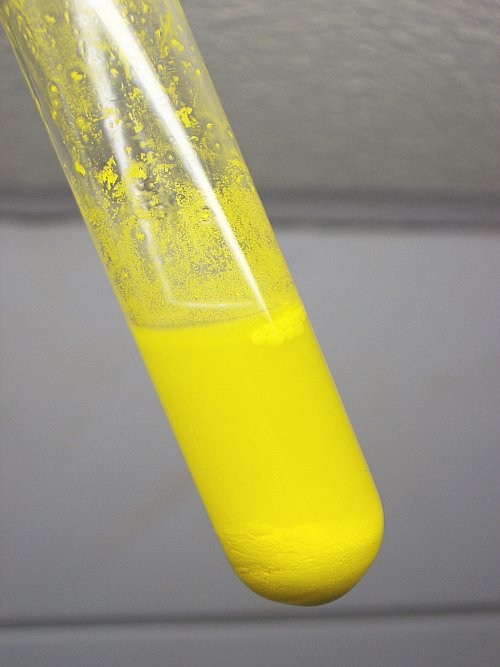
This yellow precipitate will be used in the second part of the experiment. It can be dissolved in hot water.
![]()
Golden crystals -- glittering yellow "snow"
![]() Shake the test tube with the yellow precipitate and pour its
contents in a small erlenmeyer or in a small heat-resistant glass beaker. Rinse
with some distilled water to get all precipitate in the erlenmeyer or beaker.
Add more water to the beaker, such that the total volume is approximately 30 ml.
This results in a turbid yellow liquid.
Shake the test tube with the yellow precipitate and pour its
contents in a small erlenmeyer or in a small heat-resistant glass beaker. Rinse
with some distilled water to get all precipitate in the erlenmeyer or beaker.
Add more water to the beaker, such that the total volume is approximately 30 ml.
This results in a turbid yellow liquid.
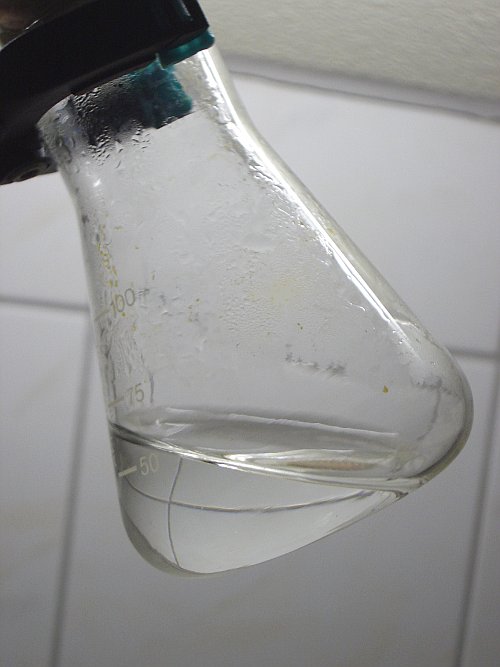
![]() Heat the liquid above a small flame and occasionally swirl the erlenmeyer or
beaker. This results in slow dissolving of the yellow solid. If not all solid
dissolves, then add a little more water and continue heating. Boiling of the
liquid should not be necessary. Finally, a colorless liquid is obtained. This
liquid is shown in the picture at the left. It just looks like plain water. The
solution is colorless and not yellow. This indicates that the yellow PbI2
is split in colorless Pb2+ ions and I– ions.
Heat the liquid above a small flame and occasionally swirl the erlenmeyer or
beaker. This results in slow dissolving of the yellow solid. If not all solid
dissolves, then add a little more water and continue heating. Boiling of the
liquid should not be necessary. Finally, a colorless liquid is obtained. This
liquid is shown in the picture at the left. It just looks like plain water. The
solution is colorless and not yellow. This indicates that the yellow PbI2
is split in colorless Pb2+ ions and I– ions.
![]() Next,
let the liquid cool down and watch what happens. Slowly, glittering crystals are
formed, which settle at the bottom. Observing this process is very nice. First,
very small crystals are formed, but at a certain point in time, the liquid is
totally filled with beautiful glittering crystals. Below, a sequence of pictures
is given with the erlenmeyer at different stages in the process.
Next,
let the liquid cool down and watch what happens. Slowly, glittering crystals are
formed, which settle at the bottom. Observing this process is very nice. First,
very small crystals are formed, but at a certain point in time, the liquid is
totally filled with beautiful glittering crystals. Below, a sequence of pictures
is given with the erlenmeyer at different stages in the process.
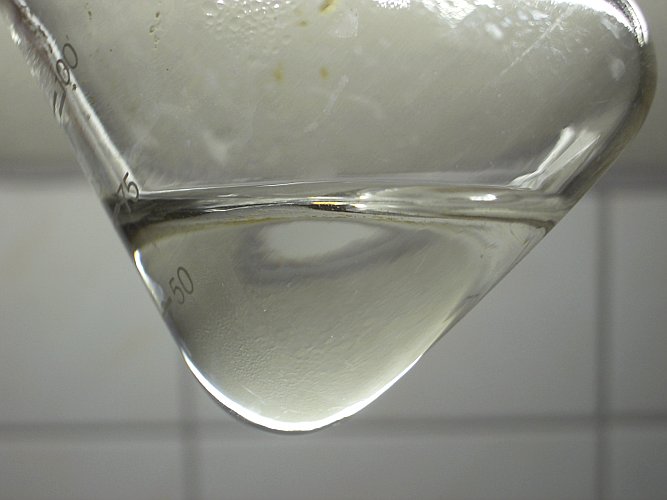
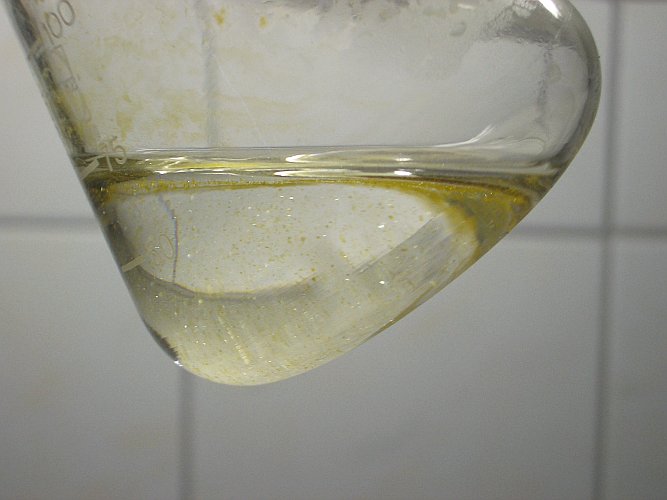
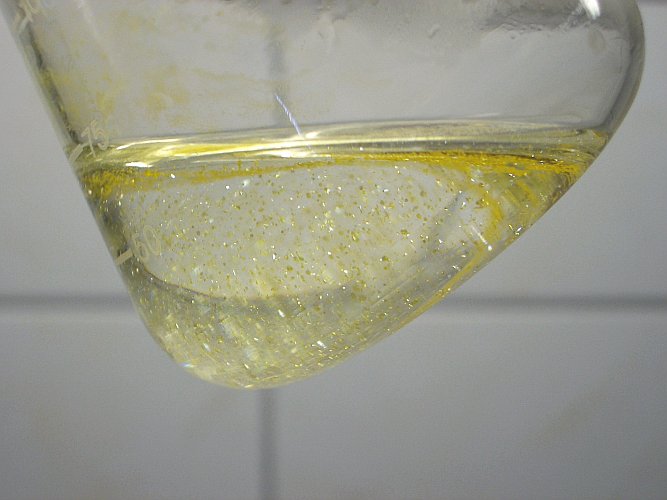
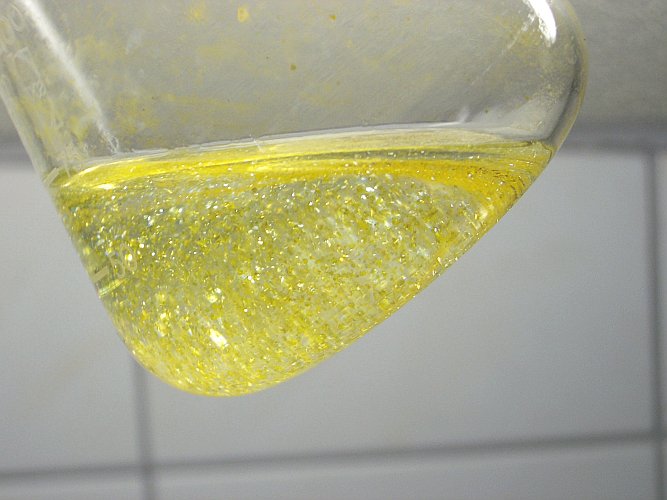
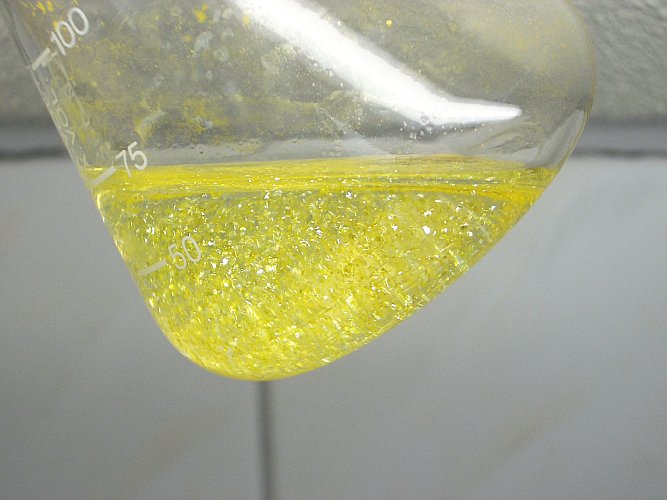
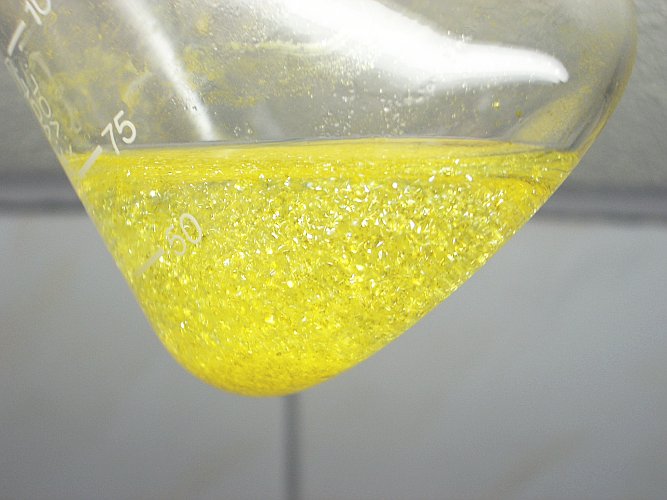
The above row of pictures was made with the erlenmeyer left undisturbed. When the erlenmeyer is swirled around, then quickly a lot of much smaller crystals are formed. This most likely is due to quicker cooling of the liquid, because of the cooled-down walls of the erlenmeyer.
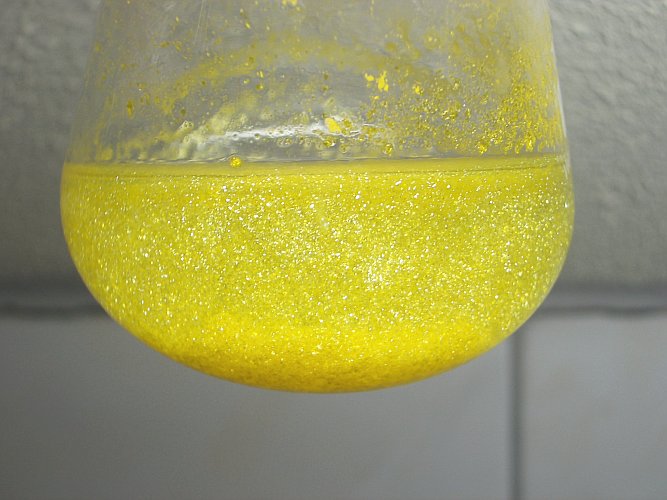
![]()
Filtering and drying of the yellow solid
![]() The crystals of lead (II) iodide are quite large and
are easily filtered with some tissue paper or a coffee filter. Let the liquid
cool down and then simply pour the liquid on a filter, placed in a funnel. A
colorless liquid is obtained and the yellow solid remains behind, leaving a nice
glittering layer of very thin crystals on the paper. The colorless liquid almost
is free of lead, it can be flushed down the drain with some water.
The crystals of lead (II) iodide are quite large and
are easily filtered with some tissue paper or a coffee filter. Let the liquid
cool down and then simply pour the liquid on a filter, placed in a funnel. A
colorless liquid is obtained and the yellow solid remains behind, leaving a nice
glittering layer of very thin crystals on the paper. The colorless liquid almost
is free of lead, it can be flushed down the drain with some water.
![]() The precipitate of lead (II) iodide is left on the
filter paper. Let this dry for a few days and then carefully rub the paper with
the solid above a glass surface (a piece of glass, or a petri dish is suitable).
The precipitate of lead (II) iodide is left on the
filter paper. Let this dry for a few days and then carefully rub the paper with
the solid above a glass surface (a piece of glass, or a petri dish is suitable).
The resulting solid is shown below. The petri dish contains almost 100 mg of solid. The solid still is nice and shiny and it is bright yellow.
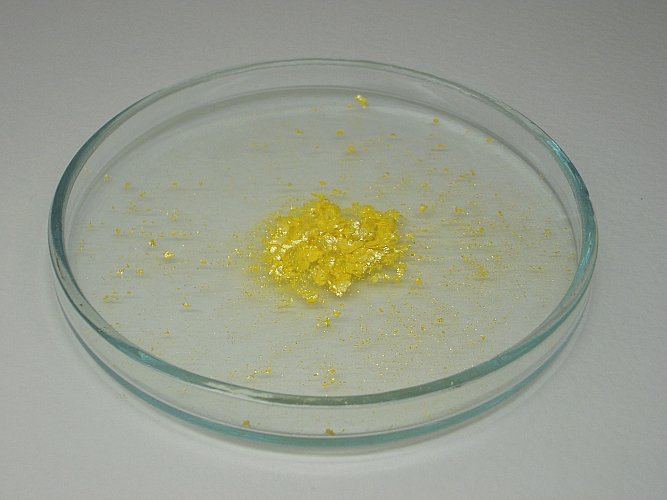
Below follow two more detailed pictures of the yellow shiny solid. It consists of very thin flakes. The flakes in turn consist of many small shiny crystals. The white specks are due to reflections of light.
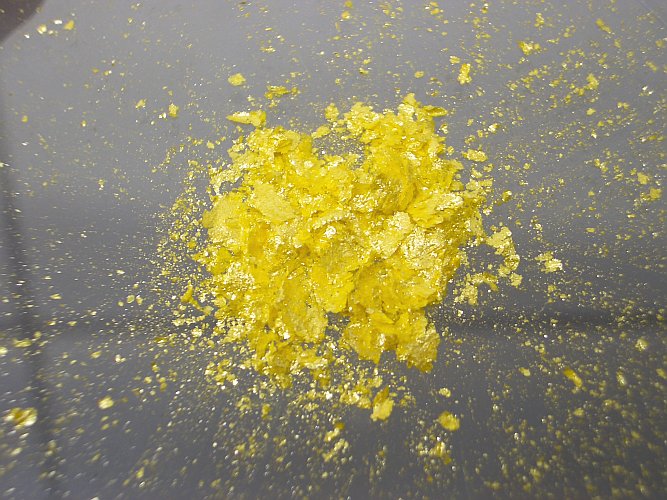
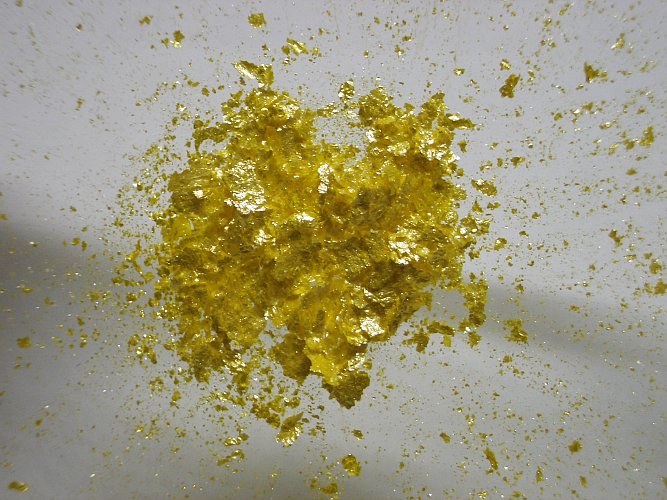
![]()
Discussion of results
![]() Lead (II) ions and iodide ions form a yellow solid, when brought together in
aqueous solution:
Lead (II) ions and iodide ions form a yellow solid, when brought together in
aqueous solution:
Pb2+ + 2I– → 2PbI2
The compound PbI2 is slightly soluble in hot water, it is insoluble in cold water. It is remarkable that this solid is yellow, while the ions, from which it is made are colorless. The yellow solid is a mainly covalent compound.